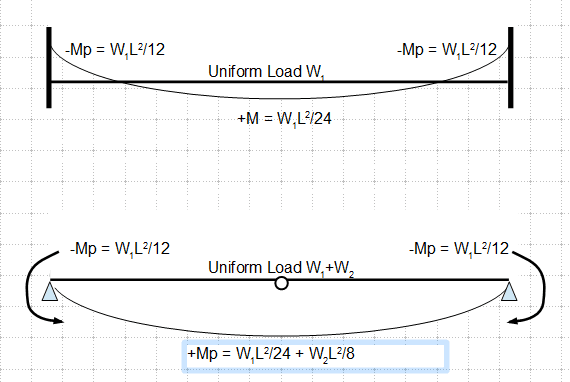Hello, I would like to get some responses about a theoretical question I have been wrestling with on numerous occasions. I think understanding the underlying concepts better would help clarify a lot of things in my head. I've attached an illustration of two recent problems that relate. Case 1 is a pipeline with bolted (in a ring pattern) flanges connecting segments of pipe, subjected to a transverse load. Case 2 is a single steel shape welded all around at each end to adjoining or supporting structure.
My question is regarding the end fixity of connections like this, but I wanted to ask it from a little bit different angle, focusing more on the forces or failure of the connection as opposed to the members. I know this is a common topic of question, and I get the general idea that every connection is somewhere between truly fixed and truly pinned. Every connection allows some degree of rotation, and every connection provides some degree of resistance to that rotation.
In case 1 of my examples, if you assume the flanges are fixed connections, the whole length becomes a single span, and the middle pipe will see greater bending stress. If you assume the flanges are pinned, then each individual span will bend, and the bending stress will be smaller. Let's say the pipe can withstand the bending stress whether the flanges are assumed fixed or pinned. But also, let's assume the flange would fail in bending if subjected to the moment they would see if fully fixed. Ideally, we would like the flanges to act as pins, allowing rotation and reducing stress in the pipes. But, for the flanges to allow rotation, there would be some degree of bending in the plate, right? So essentially the flanges have to start failing to relieve stress in the pipe?
For case 2, when looking at stress in the angle, it is more conservative to assume the welds at the ends are pins, not fixed. Let's say the angle is strong enough either way. But let's assume the weld isn't strong enough to transfer the full fixed end moment. Will the weld fail, even though this beam would be strong enough to support a simply supported condition?
To summarize my question, when you have partially restrained connections that are part of a structure with enough redundancy and strength (outside of the connections) to be stable and strong whether the connections are assumed pinned or fixed, but you have connections that would fail if subjected to the moment they would take if they're assumed fixed, do the connections actually fail, or does that moment redistribute somehow before any yielding happens in connection elements?
Hopefully I'm making a little sense here at least. I appreciate any discussion on the topic, and especially any reference texts or papers that discuss this topic that I can go read further on. Like I said, I feel like understanding what's going on here would be a lightbulb moment for a few different things in my head. Thanks!
My question is regarding the end fixity of connections like this, but I wanted to ask it from a little bit different angle, focusing more on the forces or failure of the connection as opposed to the members. I know this is a common topic of question, and I get the general idea that every connection is somewhere between truly fixed and truly pinned. Every connection allows some degree of rotation, and every connection provides some degree of resistance to that rotation.
In case 1 of my examples, if you assume the flanges are fixed connections, the whole length becomes a single span, and the middle pipe will see greater bending stress. If you assume the flanges are pinned, then each individual span will bend, and the bending stress will be smaller. Let's say the pipe can withstand the bending stress whether the flanges are assumed fixed or pinned. But also, let's assume the flange would fail in bending if subjected to the moment they would see if fully fixed. Ideally, we would like the flanges to act as pins, allowing rotation and reducing stress in the pipes. But, for the flanges to allow rotation, there would be some degree of bending in the plate, right? So essentially the flanges have to start failing to relieve stress in the pipe?
For case 2, when looking at stress in the angle, it is more conservative to assume the welds at the ends are pins, not fixed. Let's say the angle is strong enough either way. But let's assume the weld isn't strong enough to transfer the full fixed end moment. Will the weld fail, even though this beam would be strong enough to support a simply supported condition?
To summarize my question, when you have partially restrained connections that are part of a structure with enough redundancy and strength (outside of the connections) to be stable and strong whether the connections are assumed pinned or fixed, but you have connections that would fail if subjected to the moment they would take if they're assumed fixed, do the connections actually fail, or does that moment redistribute somehow before any yielding happens in connection elements?
Hopefully I'm making a little sense here at least. I appreciate any discussion on the topic, and especially any reference texts or papers that discuss this topic that I can go read further on. Like I said, I feel like understanding what's going on here would be a lightbulb moment for a few different things in my head. Thanks!

